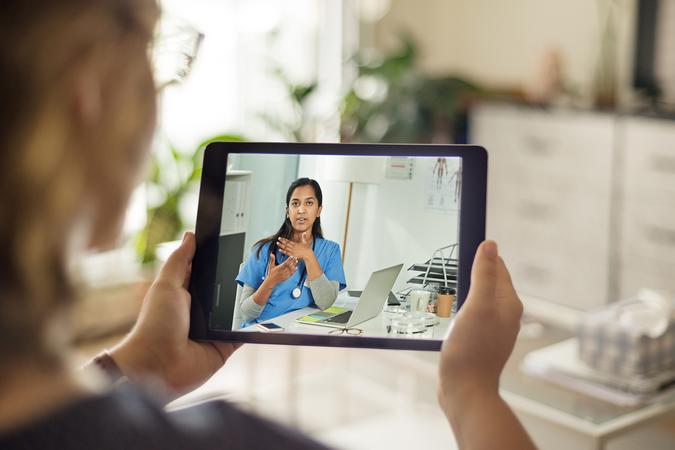For some patients, seamless telehealth requires a phone call
Telemedicine support remains a key operational challenge in clinics. IT staffing shortages, patient access and technical problems can disrupt care or negatively affect the patient experience.
Digital health series
Discover best practices and resources to implement and optimize digital health solutions.
Series OverviewSeeing inequities in care, a team at Johns Hopkins Medicine developed a simple risk-score tool to identify patients who might need more technical support in advance of a telehealth visit. Two physicians discussed this approach in an AMA-sponsored webinar, “Leveraging EHR-integrated telehealth tools to support improved patient, physician, and care team experience with virtual care.”
The webinar is part of the Telehealth Immersion Program designed to help physicians, practices and health systems implement, optimize, sustain and scale their telehealth efforts. That program is part of the AMA STEPS Forward™ Innovation Academy that lets physicians learn from peers and experts and discover ways to implement time-saving practice innovation strategies.
The benefits of expanded telemedicine are clear. Join physicians who are advocating to permanently expand virtual care coverage.
Key barriers to telehealthKey barriers to telehealth
Johns Hopkins’ telehealth journey was typical of other health systems during COVID-19.
“We’ve stabilized at around 30,000–50,000 visits a month, down from the peak of nearly 100,000” earlier in the pandemic, said Brian Hasselfeld, MD, medical director of digital health and telemedicine at Johns Hopkins Medicine.

The new influx of virtual care brought some challenges—about 1,300 Johns Hopkins clinicians in a survey reported that internet connectivity, along with audio and video connection issues, posed barriers to telehealth. IT support staff are often under-resourced and overworked.
“We began to think about ways to address that,” said Dr. Hasselfeld.
Across populations, telemedicine access isn’t equitable, noted Helen Hughes, MD, associate medical director of the office of telemedicine at Johns Hopkins Medicine. Using a telemedicine equity dashboard, her team discovered that rates of phone visits, a marker of telehealth access inequity, were higher among historically marginalized racial and ethnic groups, seniors, and patients covered by Medicaid.
Other barriers include access problems relating to broadband, privacy concerns, and personal comfort using devices, said Dr. Hughes.
Learn more with the AMA about how to implement telehealth in your practice with equity in mind.
Why audio-only telehealth visits must continueWho needs more help with telehealth?Who needs more help with telehealth?
To address inequities and make better use of resources, Drs. Hasselfeld, Hughes and colleagues developed a video visit risk-scoring system, relying on data from electronic medical records to calculate a basic risk score.
The score ranges from zero to four and takes into account factors such as whether the patient is active in the online portal, had a video visit within the prior three months or had only ever done remote visits by phone—which could reflect a failed video visit.
The basic risk score determines whether to boost the effort around a video visit, explained Dr. Hasselfeld. About 15%–20% of patients fell into the higher-score categories indicating a need for more help with accessing care via telehealth.
Find out why achieving health equity is so hard in the telehealth age.
Telehealth should be lasting care mode, not a temporary measure Calling first for timely telehealthCalling first for timely telehealth
The developers of the risk score pilot-tested this approach at three clinics and realized the tool had broad potential across Johns Hopkins and could be used by IT or front-line clinical staff, said Dr. Hughes.
Certified medical assistants (CMAs) who were supporting telemedicine received instructions on how to best use resources. For example, if a patient had a low risk score, there was no need to call in advance of an appointment, said Dr. Hughes.
For those with scores between two and four, CMAs were instructed to call patients with an active patient portal account 15 to 30 minutes before the visit to help with setup. If they didn’t have such an account, the CMAs were advised to skip to a different process, such as giving them a call and texting them a visit link outside of the portal.
Survey results show that moving to teams that specialize in virtual scheduling and readiness appears to be improving patient satisfaction, said Dr. Hasselfeld.
Future goals are to work with a telemedicine equity working group to identify ways to improve telemedicine accessibility and test other models and support roles to make telemedicine visits a more seamless experience for patients, doctors and other clinicians.








